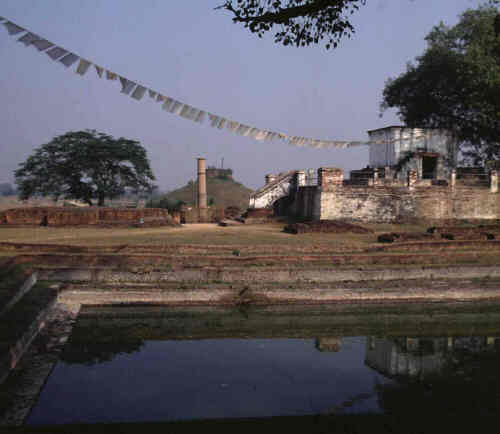 He has divided the area into three zones: at one end is Lumbini village, a complex which houses a reception centre, restaurants, hotels and other "worldly" facilities; in the middle is a cultural centre/monastic zone with a museum, research institute, and an enclave of temples representing the various schools or traditions of Buddhism; and finally, at the other end, is the heart of the whole development, the Sacred Garden, within which is located the exact place of the Buddha's birth.
He has divided the area into three zones: at one end is Lumbini village, a complex which houses a reception centre, restaurants, hotels and other "worldly" facilities; in the middle is a cultural centre/monastic zone with a museum, research institute, and an enclave of temples representing the various schools or traditions of Buddhism; and finally, at the other end, is the heart of the whole development, the Sacred Garden, within which is located the exact place of the Buddha's birth.
It is designed in such a way that visitors move along a symbolic, and literal, "middle way" - progressing from the "worldly realm" at one end along a central pathway to the "spiritual realm", as represented by the Sacred Garden, at the other.
In the garden, which will be encircled by a pond to signify its purity, visitors will be able to see important artefacts related to the Buddha's birth. According to various accounts of this great event, Queen Maya Devi, heavily pregnant with Prince Siddartha, was travelling from Kapilavastu when she decided to stop at Lumbini to rest for a while. After bathing in a pond, she felt labour pains and leaned against a sal tree for support. And it was there that she gave birth.
The exact spot is indicated by a marker stone that was discovered in 1996 during excavations at the site. It is now preserved within the newly restored Maya Devi Temple, which was reopened in 2003. On the site are the ruins of earlier temple structures which were built between the 3rd century BC and the 7th century AD.
One special artefact which has survived from earlier times is the so-called Nativity Sculpture which depicts the birth scene; it now hangs above the marker stone.
In front of the temple lies the Sacred Pool, located on the site of the original pond in which Queen Maya Devi bathed. Nearby stands the Ashokan Pillar, an important piece of archaeological evidence which established Lumbini as the Buddha's birthplace. According to an inscription, it was erected when the great Buddhist king, Ashoka, made a pilgrimage to Lumbini in 245 BC.
Outside the temple are more brick ruins of monasteries built between the 3rd century BC and the 2nd century AD, evidence that a Buddhist community once thrived in this area.
Apart from the Sacred Garden, travellers to Lumbini can also visit the monasteries of different Buddhist traditions. Among them is the Royal Thai Monastery, which has 11 resident monks and three nuns and is open to the public.
Completion of the main prayer hall is expected later this year. Future plans include the construction of facilities for meditation retreats.
Other monasteries in the international monastic zone that are now complete include those from Burma, Vietnam, Germany (built in a Tibetan style), China, India and Nepal itself.
Two meditation centres have also been opened offering instruction and retreats: the Nepal Vipassana Centre (teaching in the style of S.N. Goenka) and the Panditarama Vipassana Meditation Centre (teaching in the tradition of the Venerable Mahasi Sayadaw of Burma).
In the vicinity of Lumbini are other places of Buddhist import. Twenty seven kilometres to the west is Tilaurakot, the site of ancient Kapilavastu, the capital of the Shakya kingdom ruled by the Buddha's father. Ruins of the palace in which Prince Siddartha spent his youth can be seen, including the very gateway out of which the young man walked, leaving the material world behind to seek out the truth.
Fifty four kilometres to the east of Lumbini is Devadaha, the hometown of Prince Siddartha's mother and where he himself spent parts of his childhood.
Ramagrama, 25 kms from Devadaha, is noteworthy for its ancient stupa believed to house a complete set of one eighth of the Buddha's relics. After his death, the Buddha's relics were divided into eight parts, one given to each of eight kingdoms. These were later subdivided into thousands of parts and redistributed by King Ashoka - all except the set still kept at Ramagrama.
Buddhist Travel
Traveler Tales
In and around Lumbini
Story by NISSARA HORAYANGURA, Bangkok Post, Nov 9, 2004
Lumbini, Nepal -- Architect Kenzo Tange's master plan for Lumbini's development is large in scope - it covers an area of 2.56 square kilometres - yet minimalist in terms of aesthetics. It avoids the erection of monumental structures and is instead heavy on symbolism.



